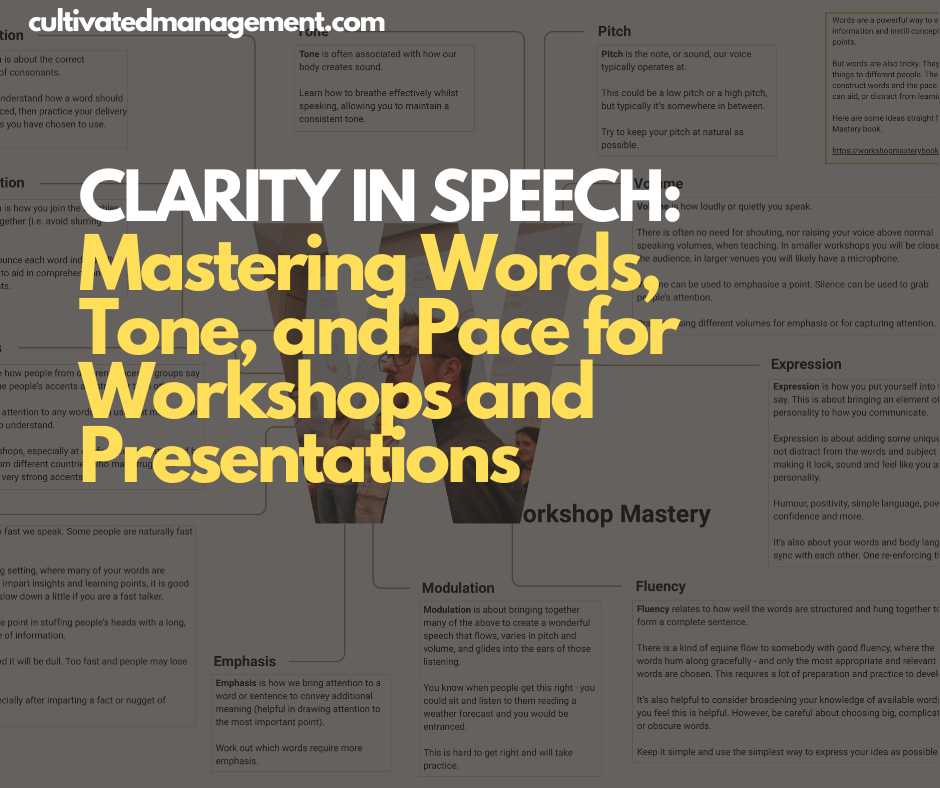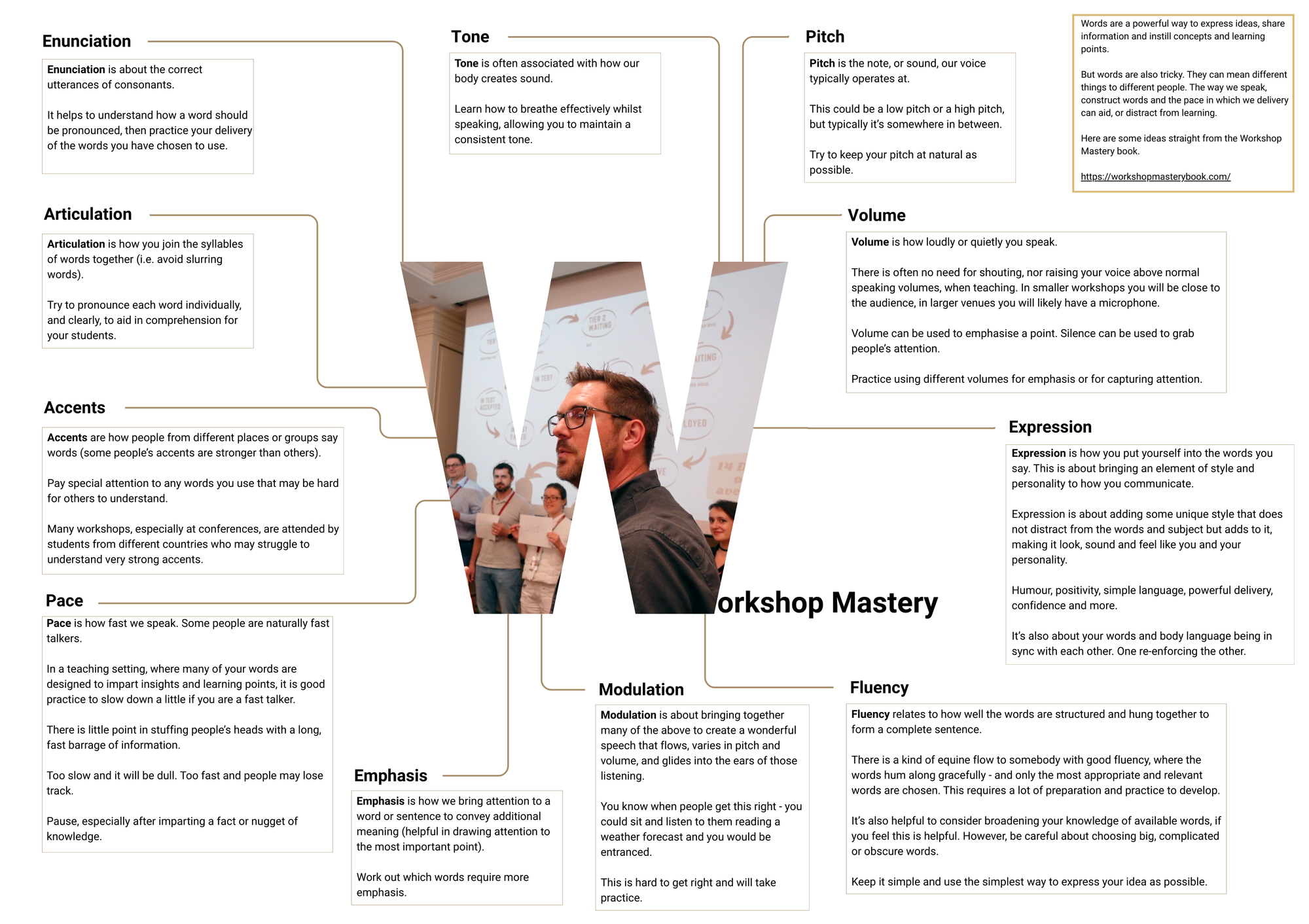
The way you speak can make or break a workshop training session. Words, tone, pace, and expression determine whether your audience learns, engages, and remembers your message.
In workshops, business sessions, and conferences, clarity is everything. Using simple words, emphasising key points, pacing your delivery, and syncing body language with your message can transform how your audience receives your ideas.
This article, drawn from my book Workshop Mastery, gives insights into the different elements of effective speech — so your ideas stick long after the session ends.
👉 Workshop Mastery is your essential guide to designing and running engaging workshops that inspire lasting impact. Packed with proven facilitation techniques, practical strategies, and real-world insights.
Teaching is communication. Information, facts, enthusiasm, and meaning all pass through the way you speak. If your communication is poor, your teaching will be too.
Communication is more than words. It’s your posture, your body language, your facial expressions, your tone, even the clothes you wear. Sometimes these things carry more weight than the words themselves. You cannot not communicate. Even silence (and your non-verbal communication) communicates something.
Words Matter
Words are the foundation. They carry ideas from your mind into your students’ minds. But words mean different things to different people.
Choose simple words. Define any jargon. Use each word consistently for one idea only. Structure your sentences logically.
Then practice. Speak your material aloud. Record yourself. Play it back. You’ll notice habits you didn’t see before — unclear phrasing, lazy choice of words, awkward delivery. Fix one thing at a time.

The Elements of Speech
Here are the fundamentals of clarity:
Enunciation is about the correct utterances of consonants. It helps to understand how a word should be pronounced, then practice your delivery of the words you have chosen to use.
Articulation is how you join the syllables of words together (i.e. avoid slurring words). Try to pronounce each word individually, and clearly, to aid in comprehension for your students.
Accents are how people from different places or groups say words (some people’s accents are stronger than others). Pay special attention to any words you use that may be hard for others to understand.
Many workshops, especially at conferences, are attended by students from different countries who may struggle to understand very strong accents.
Emphasis is how we bring attention to a word or sentence to convey additional meaning (helpful in drawing attention to the most important point). Work out which words require more emphasis.
Tone is often associated with how our body creates sound. Learn how to breathe effectively whilst speaking, allowing you to maintain a consistent tone.
Pitch is the note, or sound, our voice typically operates at. This could be a low pitch or a high pitch, but typically it’s somewhere in between. Try to keep your pitch at natural as possible.
Volume is how loudly or quietly you speak. There is often no need for shouting, nor raising your voice above normal speaking volumes, when teaching. In smaller workshops you will be close to the audience, in larger venues you will likely have a microphone.
Volume can be used to emphasise a point. Silence can be used to grab people’s attention. Practice using different volumes for emphasis or for capturing attention.
Pace is how fast we speak. Some people are naturally fast talkers. In a teaching setting, where many of your words are designed to impart insights and learning points, it is good practice to slow down a little if you are a fast talker.
There is little point in stuffing people’s heads with a long, fast barrage of information. Too slow and it will be dull – and we're always aiming to remove dullness. Too fast and people may lose track. Pause, especially after imparting a fact or nugget of knowledge.
Fluency relates to how well the words are structured and hung together to form a complete sentence.
There is a kind of equine flow to somebody with good fluency, where the words hum along gracefully - and only the most appropriate and relevant words are chosen. This requires a lot of preparation and practice to develop.
It’s also helpful to consider broadening your knowledge of available words, if you feel this is helpful. However, be careful about choosing big, complicated or obscure words. Keep it simple and use the simplest way to express your idea as possible.
Modulation is about bringing together many of the above to create a wonderful speech that flows, varies in pitch and volume, and glides into the ears of those listening.
You know when people get this right - you could sit and listen to them reading a weather forecast and you would be entranced. This is hard to get right and will take practice.
Expression is how you put yourself into the words you say. This is about bringing an element of style and personality to how you communicate.
Expression is about adding some unique style that does not distract from the words and subject but adds to it, making it look, sound and feel like you and your personality. Humour, positivity, simple language, powerful delivery, confidence and more.
It’s also about your words and body language being in sync with each other. One re-enforcing the other.
Find Your Style
No two teachers sound the same. That’s good.
First, learn the basics of communication. Then, experiment until you find a style that feels natural. Presence, authority, and personality make learning engaging.
Students pay attention when a teacher cares. They learn more when the teacher shows energy, confidence, and clarity. We all want to be taught by someone who gives a damn.
In Workshop Mastery, I go deeper into the art and craft of teaching — showing how to develop presence, authority, and a style that makes your knowledge stick with any audience
👉 Workshop Mastery is your essential guide to designing and running engaging workshops that inspire lasting impact. Packed with proven facilitation techniques, practical strategies, and real-world insights.
